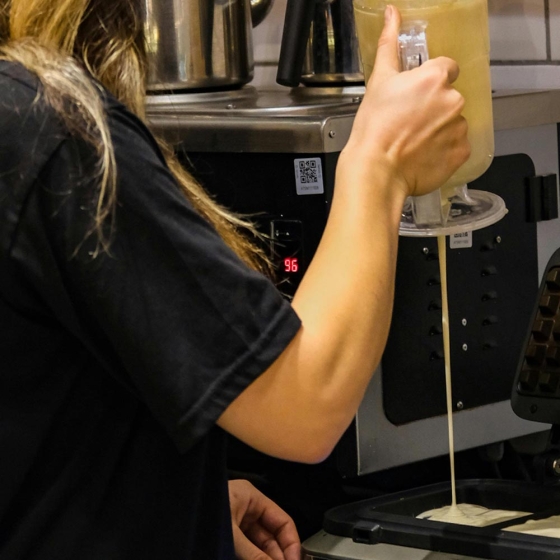
Waffle maker with adjustable timer and non-stick plates. Ideal for high-volume breakfast services.
Purchasing a commercial waffle maker is a significant investment for any food business. Whether you run a café, bakery, or food truck, the right equipment can boost efficiency and customer satisfaction. This guide will walk you through the key factors to consider, helping you make an informed decision.
Step 1: Assess Your Production Needs
Start by asking: How many waffles do I need to make per hour?
- Small businesses (e.g., coffee shops): A 2-4 slice model can handle 50-100 waffles daily.
- Medium operations (e.g., hotel breakfast service): Opt for 5-8 slice machines to serve 200-300 waffles per shift.
- Large kitchens (e.g., event catering): Choose industrial-grade models with 10+ slices and rapid heating.
Pro Tip: A dual-plate waffle maker lets you cook two batches simultaneously, cutting wait times by 30%.
Now that you’ve determined your capacity, let’s explore safety and compliance.
Step 2: Prioritize Safety and Certifications
Commercial kitchens must meet strict safety standards. Look for:
- Automatic shut-off: Prevents overheating (critical for unattended operation).
- Cool-touch handles: Protects staff from burns during busy hours.
- Certifications:
- CE Mark (Europe): Ensures compliance with EU safety and environmental rules.
- NSF/ANSI 4 (USA): Required for commercial food equipment.
Example: A bakery in Paris faced fines for using uncertified equipment—don’t make the same mistake.
Next, let’s tackle energy efficiency to reduce long-term costs.
Step 3: Evaluate Energy Efficiency
High energy bills can eat into profits. Key features to save power:
- Thick insulation: Reduces heat loss by 20-30%.
- Adjustable temperature (50-250°C): Lower temps for slow hours save energy.
- ENERGY STAR certification: Guarantees top-tier efficiency.
Case Study: A food truck in Toronto cut monthly electricity costs by CAD 120 after upgrading to an energy-efficient model.
Once you’ve considered energy use, think about ease of cleaning and maintenance.
Step 4: Simplify Cleaning and Maintenance
Sticky batter and oil buildup can slow down your kitchen. Prioritize:
- Non-stick plates: Reduce oil use by 40% and wipe clean in minutes.
- Removable plates: Dishwasher-safe parts save labor time.
- Stainless steel body: Resists rust and lasts 5+ years with proper care.
Maintenance Hack: Daily cleaning extends the machine’s lifespan by 2-3 years.
Now, let’s break down the costs to stay within budget.
Step 5: Calculate Total Ownership Costs
Avoid sticker shock by considering:
- Upfront price: 800−5,000, depending on capacity and features.
- Hidden costs:
- Energy consumption (avg. 15−50/month).
- Oil and batter usage.
- Repairs (avg. 100−300/year).
- Warranty: Aim for at least 1 year on heating elements.
Smart Choice: A 2,500machinewitha3−yearwarrantymaysave1,000+ vs. cheaper models.
Finally, always test before buying.
Step 6: Test Before Finalizing
Request a demo to check:
- Heating speed: Should reach 180°C in under 5 minutes.
- Consistency: Waffles must brown evenly across all plates.
- Noise level: Below 75 dB for open kitchens.
Quick Checklist for Buyers
☑️ Match capacity to daily demand.
☑️ Verify safety certifications for your region.
☑️ Compare energy efficiency ratings.
☑️ Prioritize easy-to-clean designs.
☑️ Calculate 3-year total costs.
☑️ Test performance with your batter recipe.
 KingHigher
KingHigher
